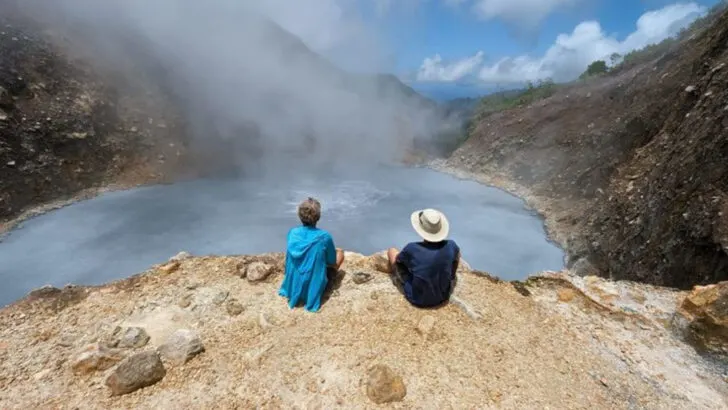While the allure of serene beaches is undeniable, certain lakes around the world pose unexpected dangers that surpass the perilous waves of some of America’s beaches.
These lakes, often cloaked in beauty, hide treacherous secrets beneath their surfaces.
From toxic waters to unpredictable weather, they challenge the unwary and the adventurous alike, demanding respect and caution. Explore these eight perilous lakes that defy their tranquil appearances with unexpected dangers.
Lake Nyos
A serene surface belies the deadly potential lurking in Lake Nyos, located in Cameroon. In 1986, this lake released a massive cloud of carbon dioxide, suffocating over 1,700 local villagers.
The lake sits atop a pocket of magma, which leaks carbon dioxide into the water. Over time, this gas accumulates until it erupts explosively.
Today, the lake’s deceptive calmness continues to hide potential danger. Scientists have installed degassing tubes to prevent another disaster, yet the threat remains. Visitors to Lake Nyos must appreciate its beauty with respect and an understanding of its deadly history.
Lake Kivu
Lake Kivu, nestled between Rwanda and the Democratic Republic of the Congo, is both a lifeline and a looming threat.
Beneath its picturesque surface lies a convection of methane and carbon dioxide, poised for a potential eruption. This lake’s volatile nature stems from nearby volcanic activity, which keeps the gases compressed under high pressure.
An eruption could release these gases, causing catastrophic consequences for millions living nearby. The lake’s beauty is captivating, but it demands vigilance and respect for its volatile nature. Efforts are ongoing to safely extract and utilize the gases commercially.
Boiling Lake
Located in Dominica, Boiling Lake lives up to its name, perpetually shrouded in steam. Its waters, heated by underlying volcanic activity, can reach temperatures near boiling point. The foreboding simmer of its surface warns visitors of its scalding waters.
The lake’s intensity is more than just thermal; it symbolizes the unpredictable power of nature. Surrounded by rugged terrain, it offers a stark reminder of Earth’s restless energy.
Boiling Lake is not for the faint-hearted, yet its raw vitality draws curious adventurers and geologists alike to witness its fiery spectacle.
Lake Michigan
Lake Michigan, one of North America’s Great Lakes, is infamous for its deadly rip currents. While its beaches might resemble a seaside escape, its waters are deceptive and unpredictable.
The lake’s expanse and position create sudden weather changes, turning a calm day into a treacherous ordeal.
Swimmers and boaters face significant risks, with strong currents claiming numerous lives each year. Despite its dangers, Lake Michigan remains a popular destination. The allure of its shimmering waters is undeniable, yet caution and respect for nature’s power are essential for every visitor.
Lake Natron
In Tanzania, Lake Natron’s blood-red color and high alkalinity create a surreal, otherworldly landscape. Its caustic waters reach pH levels akin to ammonia, preserving the bodies of birds and animals that succumb to its embrace.
Despite its harsh environment, it’s a critical breeding ground for flamingos, which thrive in its nutrient-rich waters. The lake’s eerie appearance is a stark contrast to its ecological importance.
Visitors are entranced by its unique beauty, yet must heed the lake’s toxic nature and respect the delicate balance of life it supports.
Lake Monoun
Cameroon’s Lake Monoun shares a deadly trait with its counterpart, Lake Nyos. In 1984, it released a lethal cloud of carbon dioxide, killing 37 people. Like Nyos, it sits atop volcanic ground, where gases seep into the water, building up pressure until release.
Now equipped with degassing tubes, the lake remains a silent threat. The dense forest surrounding it adds to its mystique, hiding the danger within.
Visitors to Lake Monoun should remain aware of its history, recognizing the potential for nature’s wrath hidden beneath the placid waters.
Lake Superior
The largest of the Great Lakes, Lake Superior is notorious for its treacherous storms and chilling waters. The expansive horizon seems peaceful, yet its weather can change rapidly, catching sailors and swimmers off guard. Its cold depths have claimed many ships, earning it a fearsome reputation.
Despite its dangers, Lake Superior’s beauty and size draw countless visitors. The lake’s sheer power demands respect and caution from anyone venturing near its shores.
Its icy waves and unpredictable conditions serve as a reminder of the untamable forces of nature at play.
Lake Baikal
Lake Baikal in Siberia, the world’s deepest freshwater lake, is a marvel of natural wonder and danger. Its crystal-clear waters hide a depth of 5,387 feet, creating its unique ecosystem.
Ice storms and freezing temperatures make it a difficult environment for exploration.
The lake’s ancient nature is reflected in its biodiversity, yet the same isolation contributes to unpredictable conditions.
Despite its challenges, Lake Baikal attracts those who seek its pristine beauty and enigmatic charm. The lake’s history and depth demand respect, inviting adventurers to explore with caution.

